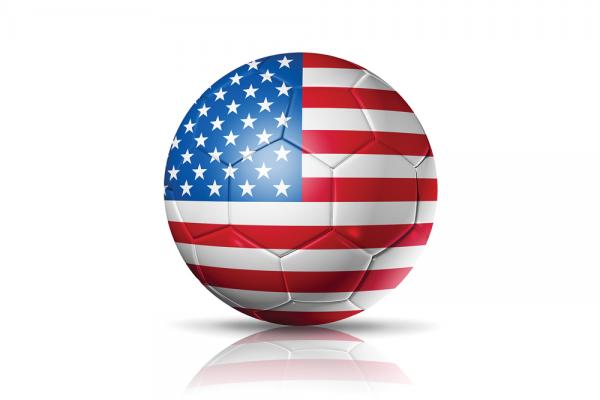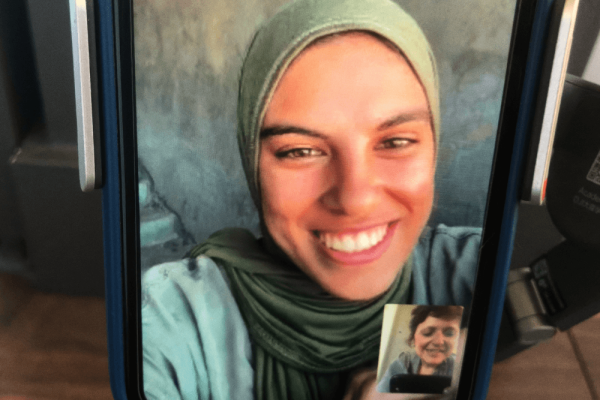IN THE SUMMER OF 2019, I fulfilled one of my childhood dreams: I cheered from the stands as the U.S. Women’s National Team won the FIFA Women’s World Cup in France.
This summer, I’ll be traveling to New Zealand and Australia to watch the team compete to win a third straight World Cup, a feat never before accomplished. I loved every moment of the 2019 tournament — the clutch penalty kicks and the cheeky goal celebrations — but two of my favorite moments came right after the final whistle blew.
The crowd of 57,900, which had been loud the whole game, got even louder.
The first chant was an easy and obvious way to cheer on the new champs: “USA! USA! USA!” I said it a couple times, but not with much gusto. It felt weird. If I said those letters, I wondered, what exactly was I cheering on? Just the team? Or also the U.S. president (at the time, Donald Trump) and his administration’s policies?
Fortunately, the chant shifted to one I could get behind wholeheartedly. As FIFA president Gianni Infantino, head of the international soccer governing body, walked to center field to begin the trophy ceremony, people around me started chanting: “EQUAL PAY! EQUAL PAY! EQUAL PAY!” Drummers behind the goal line punctuated the sound. Within seconds, the whole stadium had joined in.
At the time, a top-performing player on the U.S. Women’s National Team (USWNT) earned only 38 percent of what was earned by a top-performing player on the U.S. Men’s National Team. But as of 2022, the USWNT signed a collective bargaining agreement with the U.S. Soccer Federation that ensures that the national women’s team will be paid at the same rate for game appearances and tournament victories as the men. With this agreement, the U.S. team is setting a powerful global example. The Spanish and Canadian teams are demanding pay equity agreements with their federations. Canada’s national women’s team is wearing purple wristbands to symbolize the fight for equality in soccer and others are taking it up.
The second favorite of my World Cup afterglow moments was more polarizing. As the game ended, there was nothing but joy coming from Americans: American players rolled around in confetti on the field, American fans swayed arm-in-arm in the stands. But as the U.S. players gathered to raise the World Cup trophy, midfielder Allie Long let the U.S. flag she was holding fall to the field.
Instantly, social media lit up. “She doesn’t deserve to represent the united states,” tweeted out a Christian and “Navy mom.” Followed by, “I’m disgusted.”
Maybe the Twitter user had been emboldened by Trump. That same month, Megan Rapinoe, a USWNT captain at the time, told a journalist that she wouldn’t go to a White House championship celebration even if invited.
Trump took to Twitter to respond. “Megan should never disrespect our Country, the White House, or our Flag, especially since so much has been done for her & the team. Be proud of the Flag that you wear,” he wrote.
Just seconds after Long’s flag hit the turf, U.S. right-back Kelley O’Hara swooped it up. O’Hara became a momentary fan favorite for many conservatives online. “Whoever ran over to pick it up is my hero,” said one Twitter user. Just as quickly, the accidental hero of “patriotic” Americans became an accidental hero to queer Americans when O’Hara ran to the stands to kiss her girlfriend.
O’Hara can’t be so easily pigeonholed — and neither can the United States.
Allegiance to whom?
IN OCTOBER 2001, in the confusing aftermath of the 9/11 attacks on the U.S., the church my family attended prepared, for the first time, to display an American flag next to the cross in the sanctuary.
Then my dad caused a stink about it.
His protest surprised the congregation because my father is a retired Marine. But it didn’t surprise me. When I started elementary school, my dad told me that it was fine if I wanted to stand every morning during the Pledge of Allegiance, but he would prefer that I not actually say the words, “I pledge allegiance to the flag.”
“We can love our country,” my dad told me, “without making it a false idol.” There’s a difference between loving something and worshiping it. Placing the flag too close to the cross can get confusing for Christians — especially when American Empire is constantly claiming that God’s on its side. The Roman Empire killed Jesus because he was a threat to Pax Romana’s “peace through strength.” The Bible calls us to wage a nonviolent peace against injustice, whether personal or political.
In Notes of a Native Son, James Baldwin writes, “I love America more than any other country in this world, and, exactly for this reason, I insist on the right to criticize her perpetually.” I hear echoes of Baldwin’s words in a 2016 essay written by Rapinoe, who, like former San Francisco 49ers quarterback Colin Kaepernick, kneels during the pre-game performance of the national anthem in protest of racialized policing and racial inequity.
“[I]t is because of my utmost respect for the flag and the promise it represents that I have chosen to demonstrate in this way,” Rapinoe wrote for The Players’ Tribune. “When I take a knee, I am facing the flag with my full body, staring straight into the heart of our country’s ultimate symbol of freedom — because I believe it is my responsibility, just as it is yours, to ensure that freedom is afforded to everyone in this country.”
My church ended up siding with my dad. The flag stayed in the foyer.
Maybe it seems incongruous to cheer “USA! USA! USA!” in a Women’s World Cup stadium months after chanting “Black Lives Matter!” at a protest against racialized policing. But it’s always been complicated to love the United States.
There’s an ongoing joke among my friends that I’m only patriotic when it comes to women’s soccer. For the USWNT, I’ll fly across the ocean; I’ll paint my face red, white, and blue. Look, these women know how to ball, and that’s reason enough as it is. But they also know how to love America: by challenging us to be better.
In New Zealand and Australia, when I chant “USA! USA!” I’ll say it quietly. Not so much cheering on the U.S. for what it is now, but for what it could become: A country that sees a team full of women — Latinas, Black women, white women, gay women, straight women — and celebrates them.

Got something to say about what you're reading? We value your feedback!







